|
|
|
Sort Order |
|
|
|
Items / Page
|
|
|
|
|
|
|
| Srl | Item |
| 1 |
ID:
171170
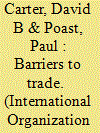

|
|
|
|
|
| Summary/Abstract |
Since trade must cross borders, to what extent do border walls affect trade flows? We argue that border walls can reduce trade flows. Even if the objective is to only stem illicit flows, border walls heighten “border effects” that can also inhibit legal cross-border flows. Using a gravity model of trade that reflects recent developments in both economic theory and econometrics, we find that the creation of a wall is associated with a reduction in legal trade flows between neighboring countries. We provide a battery of evidence that suggests this reduction is not simply a function of worsening bilateral relations. Our findings have implications for understanding how governments have taken measures to assert sovereign control of their borders in an age of increasing economic globalization.
|
|
|
|
|
|
|
|
|
|
|
|
|
|
|
|
| 2 |
ID:
182744
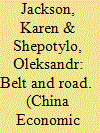

|
|
|
|
|
| Summary/Abstract |
This paper explores the impact of the Belt and Road Initiative (BRI), in terms of changes in trade costs on trade and consumer welfare in China, the EU, and the rest of the World. We employ a general equilibrium structural gravity approach and conduct a counterfactual analysis. Our key findings are as follows: (i) China and the EU are expected to make substantial gains from the BRI due to reductions in transport costs; (ii) signing and implementing a deep FTA between China and the EU is equivalent to transport cost reductions of 15–20%; (iii) the joint policy of the BRI and FTA is super-additive, magnifying the gains from the separate policies; and (iv) where transport cost reductions are 20% or more, the potential negative effect of the China-US trade war on China is more than compensated for by the BRI initiative. Our results provide evidence that the BRI has the potential to deliver significant welfare gains, particularly if combined with other trade integration schemes, and to counterbalance aggressive trade policies.
|
|
|
|
|
|
|
|
|
|
|
|
|
|
|
|
| 3 |
ID:
137929


|
|
|
|
|
| Summary/Abstract |
Using a panel gravity model of trade for the period 1995–2010, this paper estimates the potential for increased intra-regional trade among 10 countries of the southern and eastern Mediterranean coast. It examines how closer integration through the EU’s revised neighborhood policy can encourage democratisation and conflict resolution. The main results indicate that while the gains realized to date from regional integration have been small, significant potential gains from deep integration exist. The paper proposes that the EU starts by negotiating deep and comprehensive free trade agreements with Egypt, Israel and Jordan provided these countries also negotiate them with each other.
|
|
|
|
|
|
|
|
|
|
|
|
|
|
|
|
| 4 |
ID:
121806


|
|
|
|
|
| Publication |
2013.
|
| Summary/Abstract |
Shrimp farmers in the USA are facing the situation of increased imports resulting in reduced market share, falling prices, and reduced profitability for their farm-raised shrimp. The study examined the determinants of shrimp imports from China, Vietnam, Thailand, and Indonesia using an augmented gravity model of international trade. The results reveal that US imports from the four exporting countries are significantly affected by the GDP of exporting countries, GDP of the USA, exchange rate, unit import value (proxy for import price) of shrimp, and tariff. Tariff policy has implications for the US shrimp industry.
|
|
|
|
|
|
|
|
|
|
|
|
|
|
|
|
| 5 |
ID:
160546
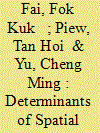

|
|
|
|
|
| Summary/Abstract |
Highly skilled diasporas are increasingly being recognized as valuable transnational resources for the economic development of their respective home countries. This study investigates the macro-level forces that have driven the spatial distribution of the highly skilled diasporas of five ASEAN countries, namely Indonesia, Malaysia, the Philippines, Singapore and Thailand. In this paper, seemingly unrelated regressions (SUR) are developed, based on the augmented gravity model of migration. The findings reveal that diaspora stocks, market size, and development level in the destination country are significant determinants. To benefit from the heterogeneity of diasporic resources, the ASEAN-5 countries should establish collaborative mechanisms to mobilize their collective pool of diasporas for economic development.
|
|
|
|
|
|
|
|
|
|
|
|
|
|
|
|
| 6 |
ID:
187832


|
|
|
|
|
| Summary/Abstract |
Telemedicine and telehealth hold promise for reducing access barriers caused by travel distance. However, little is known about how the Internet affects patients' online provider choices and thus the spatial distribution of healthcare utilization. This study investigates the effect of distance on flows of online medical consultations using a unique dataset from one of the leading third-party online healthcare platforms in China: Haodf.com. We show that the geographic distance between doctors and patients is negatively associated with online service utilization, though this effect is almost 40% ~ 50% weaker for online medical services than it is for offline medical services. We also find a strong “home bias” in which patients and doctors tend to locate in the same prefecture and in the same province. Further analyses suggest that prior in-person visits before online consultations, the potential need for a follow-up physical visit after an online consultation, and information friction may contribute to the distance effect. These findings have policy implications for improving healthcare access in China and other nations.
|
|
|
|
|
|
|
|
|
|
|
|
|
|
|
|
| 7 |
ID:
171370
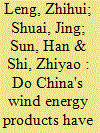

|
|
|
|
|
| Summary/Abstract |
China has become the leader in the wind energy industry and the “Belt and Road Initiative” provides a broad stage for China's international cooperation in this field. This paper examines the trade status of China's wind energy products in the “Belt and Road” countries, and measures the export potential and its determinants in the market of these countries, by adopting the gravity model with a balanced dataset of 19 products and 65 countries covering the period 2007–2017. The results indicate that: (1) China's wind energy product trade with the “Belt and Road” countries has grown rapidly, but the market structure is relatively concentrated; (2) The GDP and total energy consumption of the importing countries and China's wind power generation capacity have a positive impact on China's exports of wind energy products, while the physical distances between capitals of China and the importing countries have a negative effect; (3) The traditional market for China's wind energy product exports is becoming increasingly saturated, and 35 countries with untapped potentials and the growing markets are mainly distributed in the CIS, East Asia, West Asia, Central Asia and South Asia. Finally, this paper proposes corresponding policy implications based on these findings.
|
|
|
|
|
|
|
|
|
|
|
|
|
|
|
|
| 8 |
ID:
179935
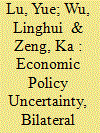

|
|
|
|
|
| Summary/Abstract |
This paper examines the effect of bilateral investment treaties (BITs) in promoting outward Chinese foreign direct investment (COFDI) in the presence of rising economic policy uncertainty in China’s partner countries. We postulate that the signing of BITs should help stimulate COFDI because the treaties send a credible signal to foreign investors about the host country’s intent to protect Chinese investment, and make it more difficult for the host country to violate its treaty obligations. BITs that contain rigorous investment protection and liberalization provisions, in particular, should be more likely to encourage COFDI as they directly influence Chinese investors’ expectations about the stability, predictability, and security of the host market. However, while BITs generally promote COFDI, host country economic policy uncertainty may also limit their effectiveness. This is because uncertainty tends to undermine investor confidence, trigger capital flows from high- to low-risk countries, and dampen commercial activities. Poisson pseudo-maximum likelihood (PPML) estimation models of the determinants of COFDI to 188 countries between 2003 and 2017 lend substantial support to our conjectures.
|
|
|
|
|
|
|
|
|
|
|
|
|
|
|
|
| 9 |
ID:
180637
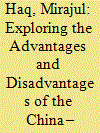

|
|
|
|
|
| Summary/Abstract |
This paper explores whether the China–Pakistan Free Trade Agreement (FTA), which entered into effect in 2007, has led to advantages or disadvantages for the participating countries. It assesses the gains and losses associated with the agreement rigorously using two different approaches. First, the revealed comparative advantage index is calculated for 10 commodity groups. This identifies the commodity groups in which the participating countries have a comparative advantage. Second, trade creation and trade diversion are estimated for overall imports and for the commodity-group level imports. This analysis provides useful information about the commodity groups in which a particular party to the FTA is experiencing an advantage or a disadvantage. The findings of the study show that China has an advantage in producing capital-intensive goods whereas Pakistan has a comparative advantage in the production of primary and semimanufactured goods. The empirical findings also indicate that, overall, the formation of the bilateral free trade agreement between Pakistan and China enhances trade with member countries as well as with nonparticipating countries.
|
|
|
|
|
|
|
|
|
|
|
|
|
|
|
|
| 10 |
ID:
086584


|
|
|
|
|
| Publication |
2009.
|
| Summary/Abstract |
This paper uses the gravity model to investigate determinants of China's wood products trade from 1995 to 2004. The results suggest that trade partners' forest resource endowment and China's own logging restrictions policy affect its wood products imports and exports. China's exported wood products are shown to be inferior goods while China's imported wood products are labor intensive for the exporting countries. Due to rises in Chinese currency against other major currency, transportation costs, and foreign trade actions, China's wood products exports and imports may slow down. The results may have implications on trade and global forest resource conservation.
|
|
|
|
|
|
|
|
|
|
|
|
|
|
|
|
| 11 |
ID:
082936
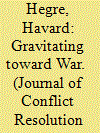

|
|
|
|
|
| Publication |
2008.
|
| Summary/Abstract |
Countries have better abilities and stronger incentives to engage in militarized conflicts the larger and more powerful they are. The article applies Zipf's notion of a ``gravity model'' to the risk of interstate conflict and argues that the empirical relationship between size and distance and conflict is stronger than any other identified in dyadic statistical studies of interstate conflict. Most empirical studies of interstate conflict fail to take size properly into account. The article shows that controlling for size variables improves the estimation of other variables of interest, and it explores the impact of omitting size variables for the investigation of the power preponderance versus power parity debate. The results indicate that even though a power capability ratio variable suggests asymmetric dyads are less conflict-prone, the risk-increasing effect of power itself means that a unilateral increase of power in one country increases the risk of conflict
|
|
|
|
|
|
|
|
|
|
|
|
|
|
|
|
| 12 |
ID:
178211
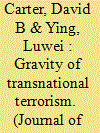

|
|
|
|
|
| Summary/Abstract |
Transnational terrorism is an inherently international phenomenon as it involves attacks where the perpetrators are from a different country than the victims. Accordingly, a growing literature explains patterns in transnational attacks with a focus on international variables, for example, the presence of a border wall or alliance patterns. Despite the importance of the topic, no common empirical framework with theoretical basis has emerged to analyze the flows of transnational attacks. We propose that recent versions of the structural gravity model of transnational flows, long the workhorse model in trade economics, can be modified to provide a theoretically motivated model of the flows of transnational terrorist attacks among countries. The gravity model provides several empirical advantages for the study of international variables and transnational terrorism, for example, recent specifications allow the researcher to estimate count models that condition out all time-varying country-level confounders with fixed effects. This facilitates sidestepping the typical problem that any international variables associated with transnational flows are often correlated with omitted or imprecisely measured domestic factors, which draws their estimates into question. Moreover, we demonstrate that the structural gravity model does a much better job in predicting outcomes, particularly when multiple attacks flow across borders.
|
|
|
|
|
|
|
|
|
|
|
|
|
|
|
|
| 13 |
ID:
147496


|
|
|
|
|
| Summary/Abstract |
In late 2011, the Spanish terrorist organization ETA announced the end of armed violence after more than forty years of illegal activity. While the existing literature has already established the negative impact of terrorist actions on international tourism in a particular region, this paper aims to determine whether ETA’s final ceasefire and definitive dissolution had a positive impact on domestic tourism in Basque Country. To that end, a directed gravity model is estimated over a panel data-set of 699 domestic tourist flows between the Spanish regions from 2008 to 2013. Results suggest that the negative impact on visitor flows was localized in the Basque Country. Also, regardless of a permanent ceasefire announced in 2010, only the 2011 ‘definitive cessation of violence’ had an immediate significant impact on the number of visitors to the Basque Country. These results complement the scarce literature on post-conflict tourism analysis and may have implications for regional authorities in affected regions in their efforts to rebuild their destination brands.
|
|
|
|
|
|
|
|
|
|
|
|
|
|
|
|
| 14 |
ID:
117635


|
|
|
|
|
| Publication |
2012.
|
| Summary/Abstract |
Cyprus is a divided island. Despite the lack of a comprehensive peace agreement reunifying the country, in 2004 trade commenced across the Green Line that separates the Greek and Turkish Cypriot communities. The volume of trade has grown steadily since, but has it reached its full potential? First, a gravity equation is estimated by using an 'out-of-sample' estimation strategy to predict potential trade for the period from 2004 to 2009. We observe a sizable gap between potential and actual volumes of trade. We then attempt to account for this gap by analyzing economic, legal, and social-psychological barriers that can explain this difference. It is found that (1) actual trade has only reached around 10% of its potential, with (2) legal constraints accounting for 35% of the missing trade, (3) extra transportation costs for about 5%, and (4) unmeasurable and social-psychological barriers for a significant amount of between 48% and 60%, depending on the year. The findings suggest that attention must be paid to the objective barriers to trade as well as the subjective interpersonal and intercommunal perceptions that can affect trade and ultimately, peaceful resolution of the conflict. These findings have implications for other conflicts in which divided communities with the potential for trading across a shared border seek to maximize the joint economic and political gains of emerging interdependence.
|
|
|
|
|
|
|
|
|
|
|
|
|
|
|
|
| 15 |
ID:
175505
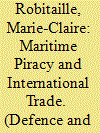

|
|
|
|
|
| Summary/Abstract |
Maritime piracy is a serious threat to international trade. Indeed, using Instrumental Variable Poisson Pseudo-Maximum Likelihood (IV-PPML) and PPML gravity models and using data on maritime distance and on piracy attacks over the period 2000–2016, it is estimated that an increase by 10 piracy attacks on the shortest maritime trade route between a country-pair results in a decrease in bilateral trade’s value by 2.8%. The impact, at 1.5%, is much smaller if the endogeneity of piracy attacks is not controlled for. Heterogeneity analysis reveals that successful attacks, attacks that involve violence, or attacks that target cargo are particularly detrimental to trade. This paper contributes to the literature by being the first to look at: non-Somali piracy attacks, different commodity groups, and various forms of attacks. This paper also proposes the use of maritime distance, instead of the commonly used great-circle distance. Finally, it offers a new instrumental variable for piracy attacks, namely, the sum of the square of the highest security apparatus index among countries in the vicinity of each vital chokepoint crossed by a ship travelling on the shortest maritime trade route between a country-pair, in a given year.
|
|
|
|
|
|
|
|
|
|
|
|
|
|
|
|
| 16 |
ID:
142030
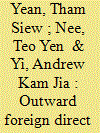

|
|
|
|
|
| Summary/Abstract |
The overall pattern of outward foreign direct investment from Malaysia indicates increasing participation in global outflows of foreign direct investment, especially to Southeast Asia. In 1980, Malaysia was ranked eleventh in the top fifteen developing and transition economies in terms of stocks of outward foreign direct investment, but it moved up to the tenth position by 2013. Outward flows surpassed inward flows after 2007 and Malaysia became a net capital exporter. This paper seeks to examine the pattern of outward foreign direct investment from the country, key motivations, and some of its impact. Government-linked companies are key players in these outward flows, especially in the oil and gas and services sector. The main findings in this paper show that outward investment from Malaysia is driven mainly by a horizontal, market-seeking type of investment while the literature indicates that its impact on trade is insignificant. Given the key role played by government-linked companies in outward foreign direct investment, an important return from these investments will be the repatriation of profits back to the home country. To promote greater transparency, these companies need to report to the public the returns and repatriation of profits on their investments abroad for Malaysia’s current and future development.
|
|
|
|
|
|
|
|
|
|
|
|
|
|
|
|
| 17 |
ID:
182801
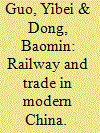

|
|
|
|
|
| Summary/Abstract |
There are controversies on the trade promoting effect of the railroad in modern times in the existing literature. We estimate the impact of the railway on domestic trade through forward linkages using an Eaton-Kortum model with county-commodity level data in Shandong and Hunan provinces in 1933. We show that the railway significantly decreased the trade cost and improved bilateral trade in Hunan and Shandong provinces. In particular, for every 10% decrease in geographical distance, the value of bilateral trade increased by 8.98%. In addition, our results on the existence of provincial border effect in Hunan and the disappearance of it in Shandong, imply that the emergence of railway contributed to the removal of provincial border effect. Furthermore, we find that counties with railway connections had higher per capita output, especially for those with a larger manufacturing sector. Our results echo those found in Andrabi and Kuehlwein (2010) and Donaldson (2018) for British India and Pérez-Cervantes (2014) for the US.
|
|
|
|
|
|
|
|
|
|
|
|
|
|
|
|
| 18 |
ID:
165372


|
|
|
|
|
| Summary/Abstract |
The present study endeavours to observe the trade creation and trade diversion effects of three free trade agreements (FTAs) in Asia, namely, India–Japan CEPA (IJCEPA), India–Sri Lanka FTA (ISFTA), and India–Bhutan FTA (IBFTA). The article aims to evaluate three uncommon FTAs that include developing–developed, developing–developing and developing–least developed countries. The objective is to evaluate the effects of these FTAs on exports and draw lessons for both the contracting parties and for other economies to commence FTAs that promote trade liberalization. This paper also aims to debunk the myth that FTAs between developing-least developed countries is not beneficial for the developing or least developed counterpart. The study applies augmented gravity model to capture the trade creation and trade diversion effects. The results confirm that ISFTA and IBFTA have trade creation effect, while in case of IJCEPA, there is trade diversion. These bilateral agreements can open the ways for multilateral trade liberalization in the long-run.
|
|
|
|
|
|
|
|
|
|
|
|
|
|
|
|
| 19 |
ID:
166739
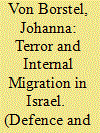

|
|
|
|
|
| Summary/Abstract |
This paper empirically analyses the effect of terror on internal migration between Israeli subdistricts. Using a unique data-set comprising migration flows for the period 1999–2012 and the number of rocket and non-rocket attacks, we test the hypotheses that terror reduces migration into an affected subdistrict and increases migration out of it. According to our results, the effect of terror on migration is asymmetric as we only find evidence for the first hypothesis. This result remains when we use an instrumental variables strategy that corrects for underreporting of the number of rocket attacks. The largest effects of rocket attacks are found for migration into the Southern subdistrict of Ashqelon as well as into other border regions in Northern Israel, while non-rocket attacks also have substantial effects in the more populous centres of Jerusalem and Tel Aviv.
|
|
|
|
|
|
|
|
|
|
|
|
|
|
|
|
| 20 |
ID:
083233


|
|
|
|
|
| Publication |
2008.
|
| Summary/Abstract |
This paper analyses the impact of terrorist activity on international tourist flows. To this end, we have estimated a cross-sectional gravity equation for tourism from the G-7 countries to a sample of 134 destinations over the period 2001-2003. Within this framework, we evaluate the deviation from 'normal' tourist flows due to terrorist activity, which is considered as negative advertising for the affected country. The analysis suggests that both domestic victims and international attacks are relevant factors when foreign tourists make their choice. This result is robust under alternative specifications. Moreover, the impact of terrorism is more severe in developing countries
|
|
|
|
|
|
|
|
|
|
|
|
|
|
|
|
|
|
|
|
|